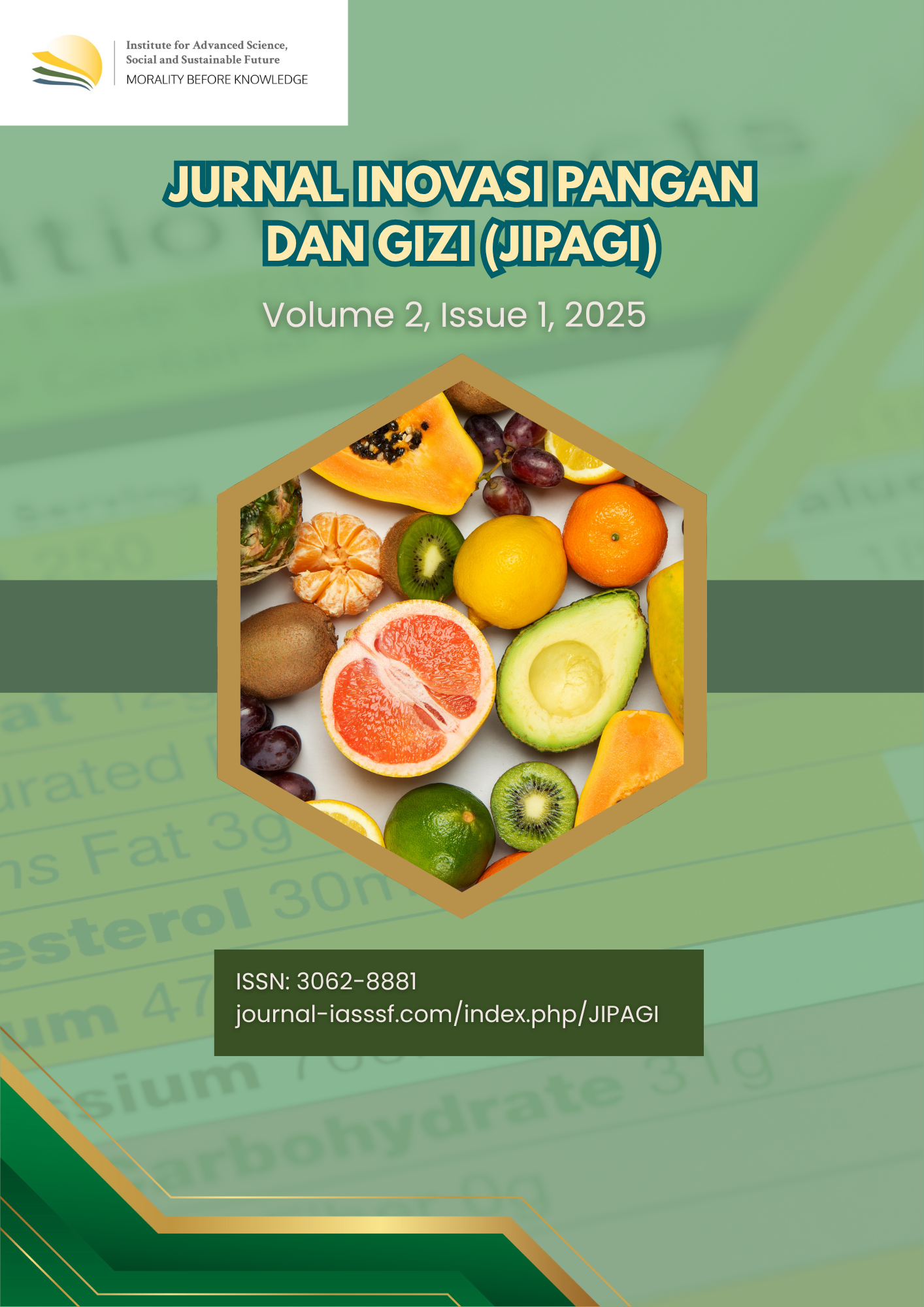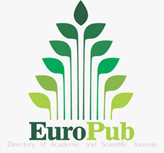The strategic role of fermented foods in enhancing sustainable food security: Integrating policy, nutritional value, and local food system empowerment
DOI:
https://doi.org/10.61511/jipagi.v2i1.2098Keywords:
fermented foods, food security, food diversification, sustainabilityAbstract
Background: Food security is a fundamental aspect of sustainable development, particularly in Indonesia, which faces challenges such as climate change, land conversion, import dependency, and uneven food distribution. Fermented foods have considerable potential to enhance the sustainability of food security by diversifying food sources, improving nutritional value, and reducing food waste. Previous studies have shown that fermentation processes can extend the shelf life of food products, increase year-round food availability, and support supply stability for communities. In addition, fermented foods contain probiotics and enzymes that benefit digestive health and nutrient absorption, thereby improving the overall nutritional quality of the population. Methods: This study utilizes a literature review to analyze a range of governmental policies and strategies aimed at optimizing the role of fermented foods in national food security. The analysis covers regulatory frameworks, incentives for local producers, and educational initiatives regarding the benefits of fermented food consumption. Findings: The findings indicate that integrating fermented foods into food security policies can promote a more resilient and sustainable food system, reduce reliance on imported products, and empower local small and medium-sized enterprises. There is a positive correlation between increased consumption of fermented foods and both improved nutritional outcomes and economic independence. Conclusion: The integration of fermented foods into national food security strategies may significantly strengthen Indonesia’s capacity to achieve a self-reliant, healthy, and sustainable food system. Novelty/Originality of this article: This article offers a novel perspective on the strategic role of fermented foods in enhancing sustainable food security in Indonesia by synthesizing policy analysis and current trends, an area that has not been extensively addressed in previous research.
References
Alhanannasir, & Sebayang, N. S. (2021). Pengolahan makanan dengan cara fermentasi. International Journal of Gastronomy and Food Science, 26. https://doi.org/10.1016/j.ijgfs.2021.100413
Ariani, M., Suryana, A., & Tono. (2023). Kinerja ketahanan pangan Indonesia: embelajaran dari penilaian dengan kriteria global dan nasional. Analisis Kebijakan Pertanian, 21(1), 1–20. https://doi.org/10.21082/akp.v21n1.2023.1-20
Astutik, R. P., Septian P. D., Andini I. N., Fitriya N. I., & Radianto D. O. (2024). Pengembangan teknologi ramah lingkungan untuk pengolahan limbah padat menuju produksi bebas limbah. Venus: Jurnal Publikasi Rumpun Ilmu Teknik, 2(2), 83–96. https://doi.org/10.61132/venus.v2i2.250
Azhari, R., Muljono, P., & Tjitropranoto, D. P. (2013). Peran penyuluh dalam peningkatan diversifikasi pangan rumah tangga. Jurnal Agro Ekonomi, 31(2), 181-198. https://doi.org/10.21082/jae.v31n2.2013.181-198
Belaineh, Y. G., Bean, S. R., Aramouni, F. M., Wu, X., Liu, S., & Tesso, T. T. (2024). Genotype and grain pretreatment effects on digestibility of sorghum proteins in the Ethiopian fermented bread. Cereal Chemistry. https://doi.org/10.1002/cche.10821
Chihombori, T. C., Mustopa, A. Z., Astuti, R. I., Mutiara, I., Refli, R., Umami, R. N., Fatimah, Irawan, H., Ekawati, N., Trinugroho, J. P., Akmaliyah, R., Chairunnisa, S., Amani, F. N., Manguntungi, B., Hertati, A., & Mamangkey, J. (2025). Potential probiotic yeasts of the pichia genus isolated from ‘dadih’, a traditional fermented food of West Sumatra, Indonesia. HAYATI: Journal of Biosciences, 32(2), 320–340. https://doi.org/10.4308/hjb.32.2.320-340
Feuerbacher, A. (2025). Pollinator declines, international trade and global food security: Reassessing the global economic and nutritional impacts. Ecological Economics, 232. https://doi.org/10.1016/j.ecolecon.2025.108565
Fujiana, F., Pondaag, V. T., Afra, A., Evy, F., & Fadly, D. (2021). Potensi pangan fermentasi tempe dalam mengatasi kejadian stunting di Indonesia. Poltekita : Jurnal Ilmu Kesehatan, 15(2), 20–26. https://doi.org/10.33860/jik.v15i2.481
Griana, T. P., & Kinasih, L. S. (2020). Potensi makanan fermentasi khas Indonesia sebagai imunomodulator. Prosiding Seminar Nasional Biologi di Era Pandemi COVID-19 Gowa, 6(1). https://doi.org/10.24252/psb.v6i1.15939
Hasan, Md. M., & Adnan, A. T. M. (2023). Nexus between environmental sustainability, energy intensity and food security: evidence from emerging economies. Journal of Business and Socio-Economic Development. https://doi.org/10.1108/jbsed-05-2023-0044
Indrianawati, M. D. N. (2019). Dampak pertumbuhan penduduk terhadap alih fungsi lahan pertanian di Kabupaten Cirebon tahun 2010-2016. Reka Geomatika, 2019(1). https://doi.org/10.26760/jrg.v2019i1.3706
Kabui, K. K., Rawson, A., & Athmaselvi, K. A. (2025). Selected fermented foods of Manipur, India: Traditional preparation methods, nutritional profile, and health benefits. Food Chemistry Advances, 6. https://doi.org/10.1016/j.focha.2024.100864
Kaur, S., Kaur, G., Kumari, A., Ghosh, A., Singh, G., Bhardwaj, R., Kumar, A., & Riar, A. (2025). Resurrecting forgotten crops: Food-based products from potential underutilized crops a path to nutritional security and diversity. In Future Foods (Vol. 11). Elsevier B.V. https://doi.org/10.1016/j.fufo.2025.100585
Ministry of Agriculture. (2019). Kebijakan Strategis Ketahanan Pangan dan Gizi 2020-2024. Kementerian Pertanian. https://badanpangan.go.id/storage/app/media/KSKPG%202020-2024%20_feb%202020.pdf
Khayeka-Wandabwa, C., Choge, J. K., Linnemann, A. R., & Schoustra, S. (2024). Linking fermented foods to microbial composition and valorisation: Blueprint for Kenya. Food Reviews International. https://doi.org/10.1080/87559129.2024.2355992
Maleke, M. S., Adebo, O. A., Wilkin, J., Ledbetter, M., Feng, X., Gieng, J., & Molelekoa, T. B. J. (2024). Effect of fermentation, malting and ultrasonication on sorghum, mopane worm and Moringa oleifera: Improvement in their nutritional, techno-functional and health promoting properties. Frontiers in Nutrition, 11. https://doi.org/10.3389/fnut.2024.1469960
Maramy, N. V., Widyaningsih, T. D., Martati, E., & Zafira, Z. (2024). Formula optimization of traditional functional beverage minasarua from Bima West Nusa Tenggara Indonesia. Trends in Sciences, 21(8). https://doi.org/10.48048/tis.2024.7693
Marco, M. L., Sanders, M. E., Gänzle, M., Arrieta, M. C., Cotter, P. D., De Vuyst, L., Hill, C., Holzapfel, W., Lebeer, S., Merenstein, D., Reid, G., Wolfe, B. E., & Hutkins, R. (2021). The international scientific association for probiotics and prebiotics (ISAPP) consensus statement on fermented foods. Nature Reviews Gastroenterology and Hepatology 18(3), 196–208. https://doi.org/10.1038/s41575-020- 00390-5
Mari, A., Kekes, T., Boukouvalas, C., Drosou, C., Krokida, M., & Tsartsaris, C. (2024). Evaluating the environmental and economic benefits of new technologies in low-salt olive fermentation. Agriculture (Switzerland), 14(11). https://doi.org/10.3390/agriculture14112077
Masekoameng, M. R., & Molotja, M. C. (2023). Contribution of indigenous food preservation and processing practices to food security of rural households In Sekhukhune District of Limpopo Province, South Africa. African Journal of Food, Agriculture, Nutrition and Development, 23(7), 24115–24135. https://doi.org/10.18697/ajfand.122.21705
Miyasto. (2014). Strategi ketahanan pangan nasional guna meningkatkan kemandirian dan daya saing ekonomi dalam rangka ketahanan nasional. Jurnal Lemhanas RI, 2(1). https://jurnal.lemhannas.go.id/index.php/jkl/article/view/151
Mulyani, R., Adi, P., & Yang, J. J. (2022). Produk Fermentasi Tradisionaln Indonesia Berbahan Dasar Pangan Hewani Daging dan Ikan. JAHT: Journal of Applied Agriculture, Health, and Technology, 1(2). https://doi.org/10.20961/jaht.v1i2.473
Murwani, R., Anggraeni, R., & Ambariyanto, A. (2024). Probiotic candidates of lactic acid bacteria from fermented food cincalok and tempoyak from Kalimantan, Indonesia. Biodiversitas, 25(8), 2705–2712. https://doi.org/10.13057/biodiv/d250843
Mutea, E., Rist, S., & Jacobi, J. (2020). Applying the theory of access to food security among smallholder family farmers around North-West Mount Kenya. Sustainability (Switzerland), 12(5). https://doi.org/10.3390/su12051751
Nasri, N., Silalahi, J., Kaban, V. E., & Satria, D. (2023). A Review on the benefits of probiotics as fermented food against several diseases. Journal of Functional Food and Nutraceutical, 41-52. https://doi.org/10.33555/jffn.v5i1.110
Nuraida, L. (2015). A review: Health promoting lactic acid bacteria in traditional Indonesian fermented foods. Food Science and Human Wellness, 4(2), 47–55. https://doi.org/10.1016/j.fshw.2015.06.001
PATPI. (2020). Ketahanan dan Keamanan Pangan Indonesia Sekarang dan Ke Depan. Perhimpunan Ahli Teknologi Pangan Indonesia. https://patpi.or.id/wp-content/uploads/2023/01/PATPI_ketahanan-keamanan-pangan-Indonesia.pdf
Peng, W., & Berry, E. M. (2019). The concept of food security. Encyclopedia of food security and sustainability, 2(1), 1-7. https://doi.org/10.1016/B978-0-08-100596-5.22314-7
Rizky, D. R., Keren, D., Pakpahan, H., Ingtyas, F. T., & Ginting, L. (2024). Meta Analisis Dampak Makanan Fermentasi Terhadap Sistem Imun Tubuh. Romulo, A., & Surya, R. (2021). Tempe: A traditional fermented food of Indonesia and its health benefits. International Journal of Gastronomy and Food Science, 26. https://doi.org/10.1016/j.ijgfs.2021.100413
Sadowski, A., Dobrowolska, B., Dziugan, P., Motyl, I., Liszkowska, W., RydlewskaLiszkowska, I., & Berłowska, J. (2024). Bread consumption trends in Poland: A socioeconomic perspective and factors affecting current intake. Food Science and Nutrition. https://doi.org/10.1002/fsn3.4383
Shin, S. M., Youn, S. J., Choi, Y., Kim, B. M., Lee, N. Y., Oh, H. J., Kwon, H. S., & Ko, H. (2024). Fermented gold kiwi for improved gastric health: Evaluation of efficacy and safety in a randomised, double-blind, placebo-controlled trial. Nutrients, 16(16). https://doi.org/10.3390/nu16162670
Simelane, K. S., & Worth, S. (2020). Food and nutrition security theory. Food and Nutrition Bulletin, 41(3), 367–379. https://doi.org/10.1177/0379572120925341
Sivashankari, M., Bagchi, T. B., Sarkar, S., & Khanam, R. (2025). Effect of different processing techniques on micronutrients retention in fermented rice water. Food Chemistry Advances, 6. https://doi.org/10.1016/j.focha.2025.100888
Sonik, M. D., Neldi, V., & Ramadhani, P. (2023). Review artikel: Efektivitas dadih (yogurt khas sumatra barat) sebagai probiotik. Jurnal Farmasi Higea, 15(1). https://www.jurnalfarmasihigea.org/index.php/higea/article/view/542/305
Sousa, N. S. O., Souza, E. S., Canto, E. S. M., Silva, J. P. A., Carneiro, L. M., Franco-De-sá, J. F. O., & Souza, J. V. B. (2023). Amazonian fermentations: an analysis of industrial and social technology as tools for the development of bioeconomy in the region. Brazilian Journal of Biology, 83. https://doi.org/10.1590/1519-6984.276493
Sundari, F. S., Putri Gitanjali Prayudani, A., Wulandari, N., Syukur, M., & Astawan, M. (2024). A nutritional, physicochemical, and sensory evaluation of tempe combination from cowpea and soybean. Indonesian Food Science and Technology, 8(1). https://doi.org/10.22437/ifstj.v8i1.36386
Syarikotin, M., Karyani, T., & Noor, T. I. (2023). Strategi Alternatif Mempertahankan dan Meningkatkan Ketahanan Pangan di Kabupaten Bandung. Jurnal Universitas Padjajaran, 1. https://jurnal.unpad.ac.id/prospekagribisnis/article/download/53466/22429
Tamang, J. P., Shin, D. H., Jung, S. J., & Chae, S. W. (2016a). Functional properties of microorganisms in fermented foods. Frontiers in Microbiology, 7(APR). https://doi.org/10.3389/fmicb.2016.00578
Tamang, J. P., Watanabe, K., & Holzapfel, W. H. (2016b). Review: Diversity of microorganisms in global fermented foods and beverages. Frontiers in Microbiology, 7(MAR). https://doi.org/10.3389/fmicb.2016.00377
Wepner, B., Neuberger, S., Hörlesberger, M., Molin, E. M., Lampert, J., & Koch, H. (2025). How can digitalisation support transformation towards sustainable agri-food systems? Scenario development in Lower Austria. Agricultural Systems, 224. https://doi.org/10.1016/j.agsy.2024.104251
Widianingrum, D. C., & Septio, R. W. (2023). Peran peternakan dalam mendukung ketahanan pangan Indonesia: Kondisi, potensi, dan peluang pengembangan. National Multidisciplinary Sciences, 2(3), 285–291. https://doi.org/10.32528/nms.v2i3.298
Zhao, J., Wang, Q., Ren, Z., Yang, C., Guan, S., Wang, X., Huang, Y., Yao, R., & Yin, H. (2024). Legendary fermented herbs: an ethnobotanical study of the traditional fermentation starter of the Chuanqing people in Northwestern Guizhou, China. Journal of Ethnobiology and Ethnomedicine, 20(1). https://doi.org/10.1186/s13002-024-00708-6
Downloads
Published
How to Cite
Issue
Section
Citation Check
License
Copyright (c) 2025 Ramzy Damasetio

This work is licensed under a Creative Commons Attribution 4.0 International License.















